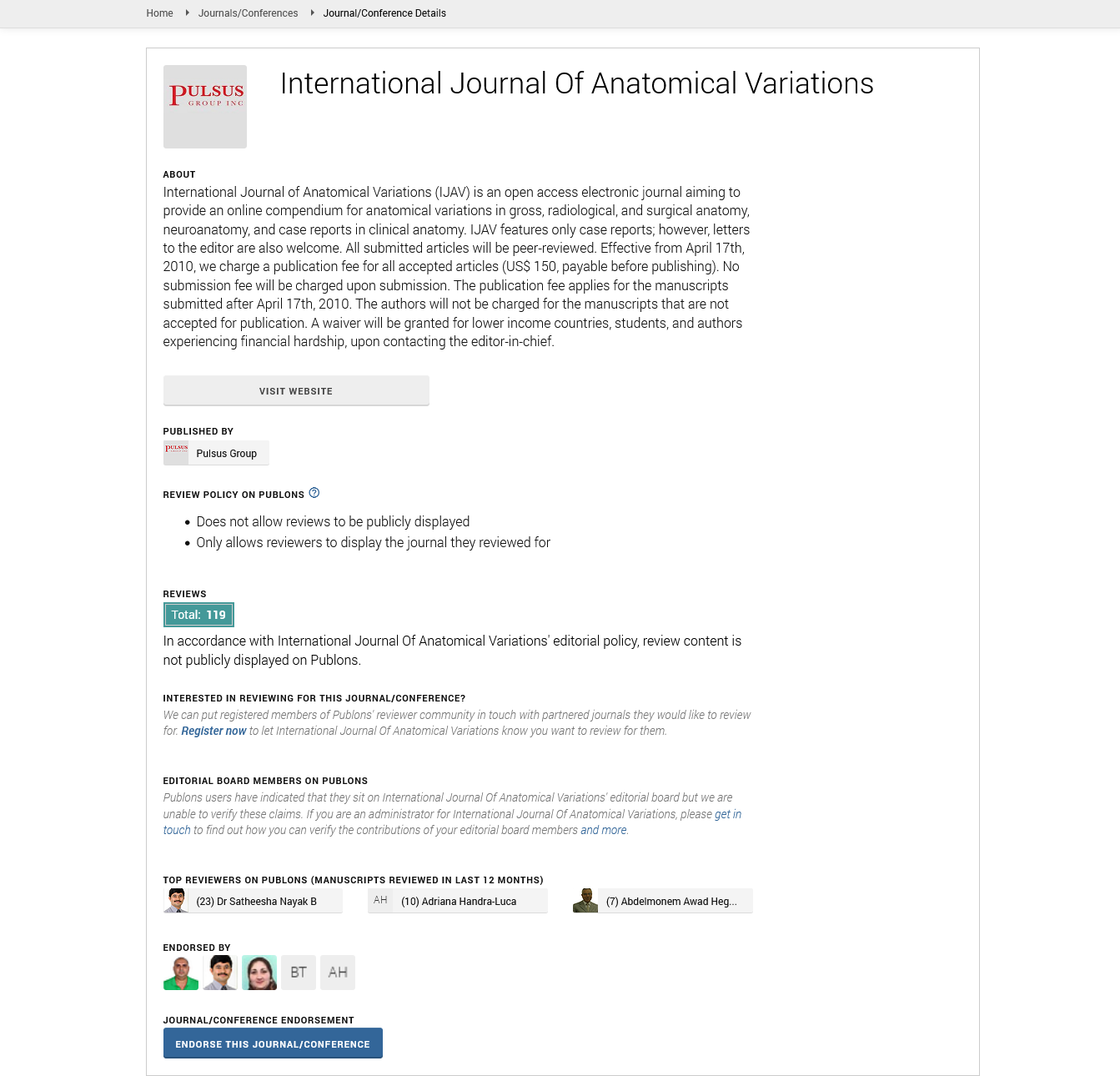Neuroanatomical Variations a Comprehensive Review
Received: 01-Feb-2025, Manuscript No. ijav-25-7621; Editor assigned: 04-Feb-2025, Pre QC No. ijav-25-7621 (PQ); Reviewed: 19-Feb-2025 QC No. ijav-25-7621; Revised: 26-Feb-2025, Manuscript No. ijav-25-7621 (R); Published: 28-Feb-2025, DOI: 10.37532/1308-4038.18(2).485
Citation: Peter J. Neuroanatomical Variations a Comprehensive Review. Int J Anat Var. 2025;18(2): 737-738.
This open-access article is distributed under the terms of the Creative Commons Attribution Non-Commercial License (CC BY-NC) (http://creativecommons.org/licenses/by-nc/4.0/), which permits reuse, distribution and reproduction of the article, provided that the original work is properly cited and the reuse is restricted to noncommercial purposes. For commercial reuse, contact reprints@pulsus.com
Abstract
Neuroanatomy is the study of the structure and organization of the nervous system. It has long been a foundational pillar of neuroscience and medicine, shedding light on the complexities of the brain, spinal cord, and peripheral nerves. Neuroanatomical variations refer to the natural differences in the structure of these systems among individuals. These variations, though subtle in many cases, can have significant implications for understanding human cognition, behavior, and the etiology of neurological disorders. This article explores the types, causes, clinical significance, and implications of neuroanatomical variations, with a particular focus on the brain, spinal cord, and other central nervous structures.
INTRODUCTION
The human nervous system is a highly complex and intricate network responsible for controlling and coordinating bodily functions. Neuroanatomical variations encompass differences in the structure [1], shape, size, and organization of neural components. These variations are often subtle, but they can profoundly affect neurological functions and behaviors. Understanding these variations is crucial for advancing medical practices, particularly in neurology, neurosurgery, psychiatry, and neuropsychology. As our understanding of neuroanatomy deepens through advancements in imaging techniques, such as magnetic resonance imaging (MRI) and functional MRI (fMRI), we are uncovering a growing body of evidence indicating that no two brains are identical. Variations may appear in regions such as the cortical folds (gyri and sulci), the size and shape of subcortical structures, the connectivity patterns between brain regions, and the volume of specific regions involved in memory, emotion, and motor control [2].
STRUCTURAL VARIATIONS
These refer to changes in the shape, size, and organization of anatomical structures within the nervous system. Structural variations include differences in: The gyri and sulci in the cerebral cortex can vary in number, depth, and pattern. These differences may influence cognitive abilities, such as language and memory, and may be associated with conditions like schizophrenia or dyslexia. The asymmetry between the left and right hemispheres of the brain, notably in language, motor control, and visuospatial processing, exhibits considerable inter-individual variation. Structures like the hippocampus, amygdala, and basal ganglia can vary in size, potentially impacting memory, emotion, and movement. For instance, reduced hippocampal volume has been associated with Alzheimer's disease. The size of the ventricles within the brain may vary. Enlargement of these spaces is often seen in neurological disorders, such as schizophrenia and multiple sclerosis [3].
FUNCTIONAL VARIATIONS
Functional neuroanatomy concerns the differences in how various brain regions perform specific tasks. The efficiency and specialization of cognitive functions such as memory, attention, and executive function can vary between individuals. Functional neuroimaging has shown that the activation patterns of specific brain regions during cognitive tasks can differ, contributing to individual differences in cognitive performance. Differences in motor areas of the brain can lead to variations in physical movement, motor learning, and response to injury. Motor cortex variability, for example, may affect fine motor skills or overall coordination. The size and activation of areas like the amygdala or the prefrontal cortex can influence emotional regulation and susceptibility to mood disorders such as depression and anxiety [4].
DEVELOPMENTAL VARIATIONS
Developmental neuroanatomical variations refer to differences in the development of the brain during embryonic and fetal stages. Specific genes can influence neural development, leading to variations in the size and connectivity of brain regions. For instance, mutations in genes like FOXP2 are associated with speech and language development. Factors such as maternal health, nutrition, toxins, and exposure to stress can affect neural development and lead to variations. The presence of fetal alcohol syndrome or prenatal exposure to drugs can result in notable neuroanatomical deviations [5].
GENETIC FACTORS
Genetic variations are a primary cause of neuroanatomical differences. Studies have shown that twin and family data suggest a strong genetic component to many aspects of brain structure. For example, research has shown that genetic variants influence cortical thickness, brain volume, and the presence of certain neuroanatomical features, such as the presence or absence of specific folds in the brain.
ENVIRONMENTAL FACTORS
Prenatal and postnatal environmental factors can influence brain development and lead to neuroanatomical differences. Malnutrition or exposure to neurotoxic substances during pregnancy or early childhood can result in significant neuroanatomical changes. Lead poisoning, for example, is associated with changes in brain structure. Chronic stress can affect brain structures, especially those involved in emotional regulation like the hippocampus and amygdala. High levels of cortisol, the stress hormone, have been linked to reductions in hippocampal volume.
NEUROPLASTICITY AND EXPERIENCE
Neuroplasticity, the brain's ability to reorganize itself based on experience, also contributes to structural variations. Experiences such as learning a new skill, trauma, or brain injury can lead to structural changes in the brain. Studies show that expert musicians, for instance, tend to have larger sensorimotor regions associated with fine motor control.
NORMAL COGNITIVE AND BEHAVIORAL DIFFERENCES
Understanding neuroanatomical variations helps explain why individuals have different cognitive abilities and behaviors. Individual differences in intelligence may be attributed to variations in the size and connectivity of specific brain regions, particularly those involved in memory and processing speed. Variations in the prefrontal cortex and amygdala may influence traits such as impulsivity, emotional regulation, and social behavior.
NEUROLOGICAL DISORDERS
Neuroanatomical variations are closely linked to various neurological conditions. Some disorders are characterized by specific structural abnormalities Studies have shown that individuals with schizophrenia often have enlarged ventricles and reduced gray matter in certain brain regions. Neurodegenerative conditions like Alzheimer's disease are characterized by shrinkage in the hippocampus and other regions involved in memory and cognitive function. Variations in brain structure, particularly in the cerebellum and the frontal lobes, have been implicated in the development of ASD.
CONCLUSION
Neuroanatomical variations are a normal part of human diversity, shaped by genetic, environmental, and experiential factors. While these variations often do not cause any immediate health concerns, they are important to consider in both clinical and research contexts. With advances in imaging technologies, our understanding of the complexities and significance of these variations continues to expand. Ultimately, these neuroanatomical differences highlight the complexity and adaptability of the human brain, underscoring the need for personalized approaches in the diagnosis, treatment, and management of neurological and psychiatric disorders. As we continue to explore the intricate relationship between structure and function, the study of neuroanatomical variations will provide valuable insights into the pathophysiology of a wide array of conditions and contribute to the development of more effective treatments.
REFERENCES
- Constable DP, Hinchcliff WK, Done SH, Grunberg W (2017) Veterinary Medicine A Textbook of the Diseases of Cattle, Horses, Sheep, Pigs, and Goats. 11th ed. Elsevier Missouri USA 1228-1238.
- Abebe A (2012) Major challenges and gaps in rabies prevention and control. In Proceedings of the national workshop on rabies prevention and control in Ethiopia. 18-19.
- Aga AM, Hurisa B, Urga K (2016) Current situation of rabies prevention and control in developing countries: Ethiopia perspective. Infectious Prev Med Infect Dis 4: 1-6.
- Cleveland S, Kaare M, Tiringa P, Mlengeya T, Barrat J (2003) A dog rabies vaccination campaign in rural Africa: impact on the incidence of dog rabies and human dog-bite injuries. Vaccine 21: 1965-1973.
- Collier L, Oxford J (2006) Human Virology. 3rd ed. Oxford University Press Inc New York, USA. 189-194.
Indexed at, Google Scholar, Crossref
Indexed at, Google Scholar, Crossref






